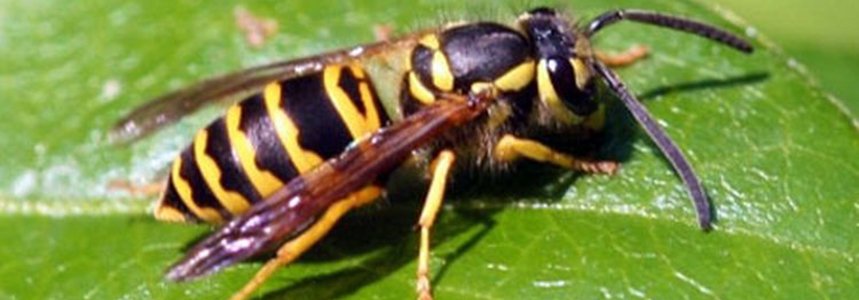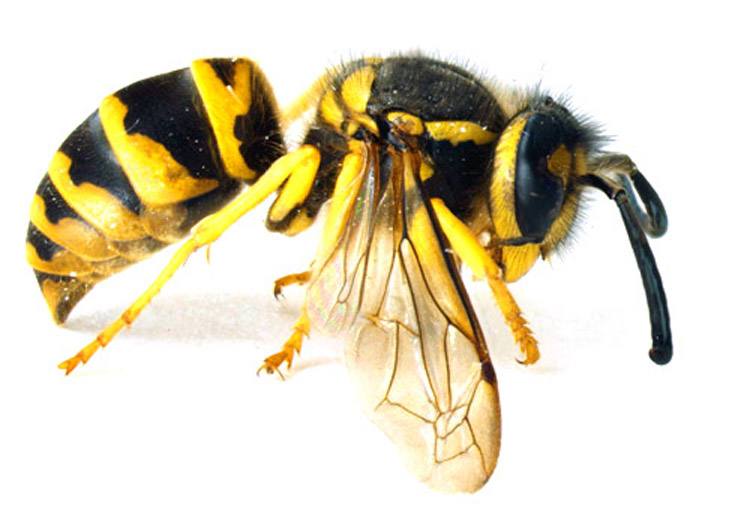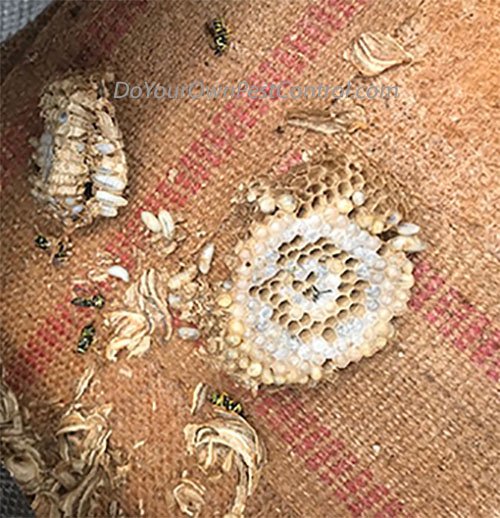How To Control Yellow Jackets
How to Get Rid of Xanthous Jackets
Yellow Jacket Nest Removal and How To Kill Yellow Jackets Safely

Getting rid of yellow jackets involves getting rid of their nests at night and preventing them from forming more than nests during the spring and summertime months.
Yellow Jacket Control Steps
Locate and Eliminate Yellow Jacket Nests
A. Sanitation ( to eliminate possible food sources)
Sanitation is of import to reduce the foraging population's build-up during the summertime to mid-autumn. Trash containers should be kept closed, and open containers should be emptied regularly.
B. Killing The Nest
Locate Nests: Nests should be located during the solar day and then that you can place the workers entering and exiting the entry points. Look for multiple entry points and marker them.
- Yellow Jackets are most agile during the hottest role of the mean solar day, then inspect for the nests at that time.
- If they have made an cloak-and-dagger nest, you lot may see small holes with the Xanthous Jacket workers entering and exiting.
- Marking the entry points
- Treat at night, when the Yellow Jackets are least agile.
Treatment: Only treat at night when it is dark. Yellow Jackets practise not run into well, and the chances of beingness stung are significantly reduced. Also, at night the whole colony will be nowadays in the nest, making the treatment more effective.
- Treat the nest with pyrethrum aerosols such as Stryker 54 Contact Aerosol or PT 565. Pyrethrum forms a gas that will fill the crenel, killing the yellowish jackets on contact.
- Look until the aerosol is dry, and then dust in the opening with insecticide dust such as Tempo Dust. The dust will prevent future hatch outs. Dust the nest, entrance, and surrounding areas. Cheque the nest the following day to run across if the yellowish jackets are dead, which can be verified past lack of activeness. Repeat, if necessary.
- Spray opening at dark with pyrethrin aerosol.
- Await until aerosol is dry out (10-fifteen minutes), then dust opening with Tempo Dust (top pick for flying insects), Evergreen Dust (a speck of botanical insecticide dust), or D Fense Dust.
- For spraying the aerosol or using the dust in hard to reach areas, the Gotcha Sprayer Pro Adaptor fits on a standard extension pole to reach areas that a ladder is required.
- For best results, utilise Walt's Yellowish Jacket Kit (Stryker 54 and Tempo Dust).
Key Takeaway
Regardless of the insecticide being used, or the nest location, treating yellow jacket nests after dark will greatly reduce your chances of being stung.
Products to Eliminate Yellow Jacket Nests
Baiting Yellow Jackets
The Alpine Yellowish Jacket Bait Stations are designed to be used with Onslaught Insecticide. You supply the station with fresh meat and the Onslaught.
The yellow jackets are lured into the bait station; they ingest the meat/insecticide mixture, killing the xanthous jackets.
This baiting system is used during the spring and summer months for the most common yellow jackets. This includes the scavenger yellow jackets that consume poly peptide and meat.
During the fall months, yellow jackets prefer carbohydrates instead of meat.
Yellow Jacket Bait Products
Trapping Yellow Jackets
Xanthous Jacket Traps are useful when you can not locate a nest. Utilize a lure like fruit juice or meat with Advantage Yellow Jacket Trap. This trap is very helpful during picnics and cookouts by drawing them away from you.
- Identify the trap away from where yous are going to be; you lot want to lure them in the trap.
- The traps come with a lure. However, meat works best early in the season, and fruit juice works well after in the summer and autumn months.
Yellow Jacket Traps
Care and Caution
With a petty care and circumspection, yellow jackets can be easily and safely eliminated.
- Treat nest directly at night
- Hang traps or bait stations away from children, people, and animals.
Yellow Jackets Are Aggressive
All wasps will defend their nests, but Xanthous Jackets and hornets are the most aggressive. They can be distinguished from bees by their sparse "waists." Bees are thick-wasted. Yellow Jackets fold their wings lengthwise when at residuum. If a colony is disturbed, the Yellow Jackets can become very aggressive and sting. Make certain to inspect for yellow jacket nests earlier mowing the backyard or using trimmers. For most people, the yellow jacket sting is temporary simply painful. However, for allergic individuals, a single sting may result in a serious reaction that requires medical treatment.
Xanthous Jacket Identification and Habits
- Size: five/8 to 1 inch
- Color: Black and Yellowish or Black and White
- They have a thin waist, in dissimilarity to a bee.

What Yellowish Jackets Eat
Like all wasps, yellowish jackets casualty on a variety of insects and other arthropods. Yellow jackets will also provender on foods that people eat, especially sweets and meats. Yellow jackets are considered beneficial insects because they eat other insects. All the same, they are a nuisance to people because they are aggressive and exit painful stings. At that place are several yellow jackets in the The states; the western yellow jacket is the most mutual type, constitute in the northern temperate climates. The yellow jacket colony will remain agile for only one summer. The queens volition fly abroad to kickoff more colonies. The remaining ones die at the finish of the season. The nest is not reused (with the occasional exception of High german yellow jackets).
Yellowjacket Habits
Yellow Jackets are of the Vespula species and are social wasps. Several thousand workers can exist produced in a colony in one season.
Types of Yellow Jackets and Xanthous Jacket Nests
Yellow Jackets are of the Vespula species and are social wasps. Several g workers can be produced in a colony in ane flavor.
- Yellowish jackets found in structures: The High german Yellowjacket, which originated in Europe, is located beyond the northeastern and midwestern regions of the Usa. It is widely distributed throughout much of the temperate areas of the USA. The German Yellowjacket usually nests in structures, wall voids, crawlspaces, attics, and cracks and crevices in the exterior surface of a building. The German yellowjacket has been a threat to the beekeeping industry. An entire colony of bees can be destroyed by aggressive workers. These Yellowish jackets make nests of paper from fibers in wood and saliva. The German yellowjacket volition reuse the previous year's nest.
- Xanthous jackets are constitute in both structures and ground: The common yellowjacket, Vespula Vulgaris, occurs in many states of the Us. They construct both higher up-ground and below-footing nests. The Eastern yellowjacket by and large has ground nests, but an aerial nest does occur. The Southern Yellowjacket (Vespula squamosa) has both aeriform and terrestrial nests.
- Yellowish Jackets constitute in the ground: The Western Yellowjacket (Vespula pensylvanica) and Eastern Yellowish Jackets ( Vespula maculifrons ) make their nests in the footing. Many people refer to yellow jackets as "meat bees." Yellow jackets will also utilise rodent burrows for nests, enlarging the cavity equally the colony develops. You tin can see pocket-sized stones or clay particles piled upwards effectually the openings of a burrow that is used to house a large yellow jacket colony. They will ofttimes utilise other material near ground level that has available openings, such as railroad ties or concrete blocks.
- Aerial Nests: Some Yellow jackets (D. areanara and D.maculata) build aerial nests hanging from a tree or attached to the eaves of buildings. These xanthous jackets are not as aggressive. Use the Structural Yellow Jacket Kit in these situations.

Prevent Yellow Jackets
Xanthous jackets (along with bees, wasps, and hornets) in our yards and landscapes are beneficial insects, but they can exist a nuisance, and to some, a serious health hazard.
In many cases you tin can avert bug with yellowish jackets in the summer past doing three things:
- Finding and eliminating nests in late spring and early summer when their numbers are depression and their nests are still small.
- Reduce their access to food.
- Trapping yellow jackets.
If you seem to have yellow jackets year after year, inspect the area in the late spring/early on summer and then that you lot can locate and treat any newly formed nests. Nests can almost frequently be found in the ground but may exist under overhangs or in wall voids of buildings. Ground nests are ofttimes located under bushes and shrubs, logs, landscape timbers and other protected areas. Entrance holes may have blank dirt around them. If y'all think you have institute a nest, spotter the opening to meet if the yellow jackets are coming and going. Nests can occasionally be institute in hollow posts, play equipment, and under outdoor tables and chairs.
Another method of preventing yellow jackets is to limit their admission to food. Any food left outdoors, open trash cans, or uncovered compost piles should exist removed or covered. Yellow jackets will remember the location of nutrient sources, and volition return to search that area over again and again. Trash cans should have tight fitting lids and should be emptied and cleaned oftentimes.
Trapping is another important tool in preventing yellow jackets. Information technology will not eliminate yellow jackets, just can profoundly reduce their numbers. Traps are baited with an attractant and volition allow yellowish jackets to enter, but not escape. It is important to place traps around the perimeter of the expanse you want to protect so that y'all draw the yellow jackets away from that surface area. Exist aggressive and apply plenty of traps. Empty the traps and modify bait frequently to ensure significant xanthous jacket population reduction. Remember to ever place traps out of reach of children.
Post-obit these three steps in the spring and early summer should lead to fewer encounters with yellow jackets subsequently in the twelvemonth.
Here is an first-class video from the University of California describing the difference between xanthous jackets, wasps, and mud daubers.
Written by our resident pest control expert Ken Martin.
How To Control Yellow Jackets,
Source: https://diypestcontrol.com/yellowjackets.htm
Posted by: plascenciaribut1995.blogspot.com


0 Response to "How To Control Yellow Jackets"
Post a Comment